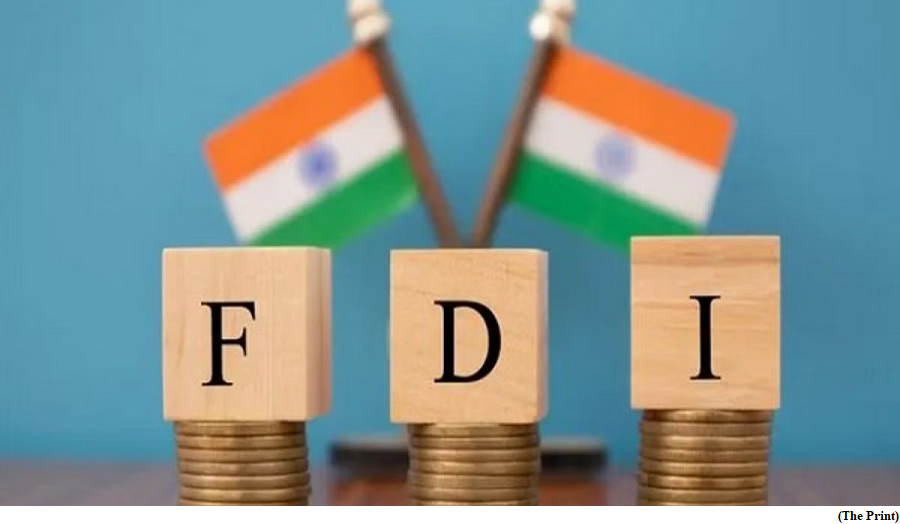India received 3rd highest FDI in the world in 2022 (GS Paper 3, Economy)

Why in news?
- Recently, the 2023 edition of the World Investment Report was released by United Nations Conference on Trade and Development (UNCTAD).
Highlights about India:
- India was the third largest recipient of foreign direct investment (FDI) in greenfield projects in the world in 2022.
- The FDI flows into India rose 10 per cent from $44.7 billion in 2021 to $49.3 billion in 2022. This is lower only than the FDI flows into the US and the UK.
- Apart from a sharp increase in foreign investment in greenfield projects in India, India was the second-largest recipient of international project finance in the world in 2022.
- International project finance is when international lenders provide debt or equity to infrastructure projects in various countries.
- The inflows into India in 2022 were, however, significantly lower than what was seen in 2020 during the Covid-19 pandemic, during which $64 billion of FDI entered the country.
Global scenario:
- The United States remained the largest host for announced greenfield projects and international project finance deals, followed by the United Kingdom, India, the United Arab Emirates and Germany for greenfield projects, and by India, the United Kingdom, Spain and Brazil for project finance deals.
- India and ASEAN were the most buoyant recipients, with increases of 10 and 5 per cent, respectively, and strong growth in project announcements.
- China, the second largest FDI host country in the world, saw a 5 per cent increase.
Largest FDI deals in India:
- The report highlighted a few recent FDI deals in India, with several of the largest deals associated with the Adani Group.
- Among the largest greenfield projects were the plans by Foxconn and Vedanta Resources to build one of the first chip factories in India for $19 billion and a $5 billion project to produce urea from green hydrogen by a joint venture of TotalEnergies (France) and Adani Group.
- In project finance deals POSCO (Republic of Korea) and the Adani Group sponsored the construction of a steel mill for $5 billion in Gujarat.
Investment by Indian Companies:
- While India saw a surge in inward FDI, it also saw growth in the flow of investments made by Indian companies in other countries.
- The greenfield project announcements by Indian multinational enterprises more than tripled to $42 billion.
- Two of the largest greenfield projects were in renewables, with Acme Group announcing a $13 billion plant in Egypt to produce 2.2 billion tonnes of green hydrogen annually and ReNew Power announcing that it will set up a $8 billion green hydrogen plant in the Suez Canal Economic Zone.
Understanding dark patterns
(GS Paper 3, Economy)
Why in news?
- The Department of Consumer Affairs and the Advertising Standards Council of India (ASCI) recently held a joint consultation with stakeholders on the menace of ‘dark patterns’.
- The ASCI has come up with guidelines for the same, with the central government also working towards norms against ‘dark patterns’.

What are dark patterns?
- Harry Brignull, a user experience researcher in the U.K., introduced the phrase ‘dark pattern’ in 2010 to characterises deceptive strategies used to trick clients.
- A dark pattern refers to a design or user interface technique that is intentionally crafted to manipulate or deceive users into making certain choices or taking specific actions that may not be in their best interest. It is a deceptive practice employed to influence user behaviour in a way that benefits the company implementing it.
- For example, a common dark pattern is the “sneak into basket” technique used on e-commerce websites. When a user adds an item to their shopping cart, a dark pattern may be employed by automatically adding additional items to the cart without the user’s explicit consent or clear notification.
- This can mislead the user into purchasing more items than they intended, potentially increasing the company’s sales but compromising the user’s autonomy and decision-making.
- By using such dark patterns, digital platforms infringe on the consumer’s right to full transparency of the services they use and control over their browsing experience.
What are the different types?
- Businesses are using various techniques and deceptive patterns to downgrade the user experience to their own advantage.
- Some of the common practices are
- creating a sense of urgency or scarcity while online shopping;
- confirm shaming wherein a consumer is criticised for not conforming to a particular belief;
- the forced action of signing up for a service to access content;
- advertising one product or service but delivering another, often of lower quality, known as the bait and switch technique;
- hidden costs where the bill is revised or costs are added when the consumer is almost certain to purchase the product;
- disguised advertisements of a particular product by way of depicting it as news and many more.
- Such deceptive patterns that manipulate consumer choice and impede their right to be well-informed constitute unfair practices that are prohibited under the Consumer Protection Act 2019.
Are dark patterns illegal?
- Many believe that the use of dark patterns is a business strategy. The legality of dark patterns is a complex matter as distinguishing between manipulation and fraudulent intent can be challenging.
- As of now, there are no specific regulations in place in most nations against dark patterns.
- In 2022, Google and Facebook faced repercussions due to their cookie banners.
- These companies violated EU and French regulations by making it more difficult for users to reject cookies as compared to accepting them.
What are global regulators saying?
- Major international authorities are acting and formulating rules to address the issue.
- The Competition and Markets Authority (CMA) of the U.K. lists different pressure-selling techniques that the CMA believes would likely violate consumer protection laws and for which actions will be taken.
- Guidelines from the European Data Protection Board were released in 2022 and offered designers and users of social media platforms practical guidance on how to spot and avoid so-called “dark patterns” in social media interfaces that are in violation of General Data Protection Regulation (GDPR) laws.
How India addresses dark patterns?
- The Department of Consumer Affairs and the ASCI have identified the issue and recently taken certain steps to handle the same.
- As of now, companies are being asked to desist from using such tactics in the e-market and on June 30, 2023, major Indian online marketplaces received a letter from the Department of Consumer Affairs warning them against engaging in “unfair trade practices” by implementing “dark patterns” in their user interfaces to influence consumer choice and infringe on “consumer rights” as stated in Section 2(9) of the Consumer Protection Act, 2019.
- However, with the growing use of e- platforms, a robust legal mechanism is a demand.
- The Indian government should also amend existing laws to specifically address dark patterns. To do this, new rules aimed against deceptive design practices may need to be introduced along with updated consumer protection laws and data protection legislation.
What are the provisions of the High Seas Treaty?
(GS Paper 2, International Organisation)
Why in news?
- Recently, the UN adopted the Marine Biodiversity of Areas Beyond National Jurisdiction (BBNJ) or the High Seas Treaty.
- It became the third agreement to be approved under UNCLOS, after the 1994 and 1995 treaties, which established the International Seabed Authority and the Fish Stocks agreement.

When did the process start?
- The idea of protecting the marine environment emerged in 2002. By 2008, the need for implementing an agreement was recognised, which led to the UNGA resolution in 2015 to form a Preparatory Committee to create the treaty.
- The Committee recommended the holding of intergovernmental conferences (IGC) and after five prolonged IGC negotiations, the treaty was adopted in 2023.
- The treaty’s objective is to implement international regulations to protect life in oceans beyond national jurisdiction through international cooperation.
What does the treaty entail?
- It aims to address critical issues such as the increasing sea surface temperatures, overexploitation of marine biodiversity, overfishing, coastal pollution, and unsustainable practices beyond national jurisdiction.
- The first step is establishing marine protected areas to protect oceans from human activities through a “three-quarterly majority vote,” which prevents the decision from getting blocked by one or two parties.
- On the fair sharing of benefits from marine genetic resources, the treaty mandates sharing of scientific information and monetary benefits through installing a “clear house mechanism.”
- Through the mechanism, information on marine protected areas, marine genetic resources, and “area-based management tools” will be open to access for all parties. This is to bring transparency and boost cooperation.
- The last pillar of the treaty is capacity building and marine technology.
- The Scientific and Technical Body will also play a significant role in environmental impact assessment. The body will be creating standards and guidelines for assessment procedures, and helping countries with less capacity in carrying out assessments.
Why did it take so long to sign?
- The marine genetic resources issue was the treaty’s most contended element. The parties to the treaty must share and exchange information on marine protected areas and technical, scientific and area-based management tools to ensure open access of knowledge.
- The negotiations on the subject were prolonged due to the absence of a provision to monitor information sharing.
- In IGC-2, small island states supported the idea of having a licensing scheme for monitoring, but was opposed by the likes of the U.S., and Russia, stating its notification system would hinder “bioprospecting research.”
- Another debate was over definition. The use of the phrases “promote” or “ensure” in different parts of the treaty, especially with respect to the sharing of benefits from marine genetic resources, was heavily debated over.
- And finally, there was the prolonged negotiation over the adjacency issue. This was specifically applicable to coastal states whose national jurisdictions over the seas may vary.
- This meant it required special provisions where it can exercise sovereign rights over seabed and subsoil in the jurisdiction beyond. It prolonged the decision-making as it affects the interests of landlocked and distant states.
Who opposed the treaty?
- Many developed countries opposed the treaty as they stand by private entities which are at the forefront of advanced research and development in marine technology (patents relating to marine genetic resources are held by a small group of private companies).
- Russia and China also are not in favour of the treaty. Russia withdrew from the last stage of reaching a consensus in IGC-5, arguing that the treaty does not balance conservation and sustainability.




